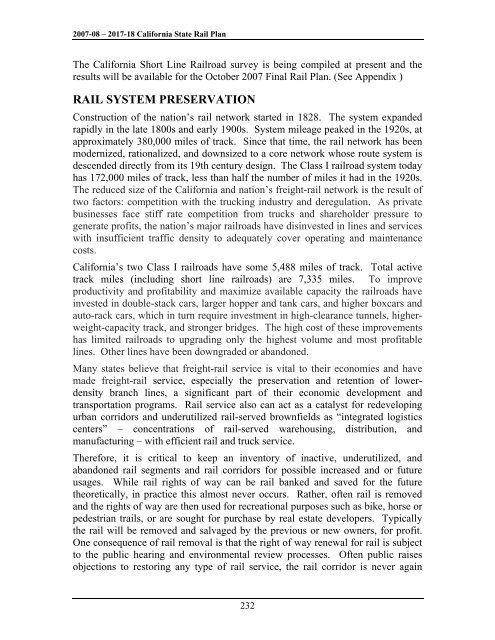California State Rail Plan 2007-08 to 2017-18
California State Rail Plan 2007-08 to 2017-18
California State Rail Plan 2007-08 to 2017-18
- No tags were found...
Create successful ePaper yourself
Turn your PDF publications into a flip-book with our unique Google optimized e-Paper software.
<strong>2007</strong>-<strong>08</strong> – <strong>2017</strong>-<strong>18</strong> <strong>California</strong> <strong>State</strong> <strong>Rail</strong> <strong>Plan</strong>The <strong>California</strong> Short Line <strong>Rail</strong>road survey is being compiled at present and theresults will be available for the Oc<strong>to</strong>ber <strong>2007</strong> Final <strong>Rail</strong> <strong>Plan</strong>. (See Appendix )RAIL SYSTEM PRESERVATIONConstruction of the nation’s rail network started in <strong>18</strong>28. The system expandedrapidly in the late <strong>18</strong>00s and early 1900s. System mileage peaked in the 1920s, atapproximately 380,000 miles of track. Since that time, the rail network has beenmodernized, rationalized, and downsized <strong>to</strong> a core network whose route system isdescended directly from its 19th century design. The Class I railroad system <strong>to</strong>dayhas 172,000 miles of track, less than half the number of miles it had in the 1920s.The reduced size of the <strong>California</strong> and nation’s freight-rail network is the result oftwo fac<strong>to</strong>rs: competition with the trucking industry and deregulation. As privatebusinesses face stiff rate competition from trucks and shareholder pressure <strong>to</strong>generate profits, the nation’s major railroads have disinvested in lines and serviceswith insufficient traffic density <strong>to</strong> adequately cover operating and maintenancecosts.<strong>California</strong>’s two Class I railroads have some 5,488 miles of track. Total activetrack miles (including short line railroads) are 7,335 miles. To improveproductivity and profitability and maximize available capacity the railroads haveinvested in double-stack cars, larger hopper and tank cars, and higher boxcars andau<strong>to</strong>-rack cars, which in turn require investment in high-clearance tunnels, higherweight-capacitytrack, and stronger bridges. The high cost of these improvementshas limited railroads <strong>to</strong> upgrading only the highest volume and most profitablelines. Other lines have been downgraded or abandoned.Many states believe that freight-rail service is vital <strong>to</strong> their economies and havemade freight-rail service, especially the preservation and retention of lowerdensitybranch lines, a significant part of their economic development andtransportation programs. <strong>Rail</strong> service also can act as a catalyst for redevelopingurban corridors and underutilized rail-served brownfields as “integrated logisticscenters” – concentrations of rail-served warehousing, distribution, andmanufacturing – with efficient rail and truck service.Therefore, it is critical <strong>to</strong> keep an inven<strong>to</strong>ry of inactive, underutilized, andabandoned rail segments and rail corridors for possible increased and or futureusages. While rail rights of way can be rail banked and saved for the futuretheoretically, in practice this almost never occurs. Rather, often rail is removedand the rights of way are then used for recreational purposes such as bike, horse orpedestrian trails, or are sought for purchase by real estate developers. Typicallythe rail will be removed and salvaged by the previous or new owners, for profit.One consequence of rail removal is that the right of way renewal for rail is subject<strong>to</strong> the public hearing and environmental review processes. Often public raisesobjections <strong>to</strong> res<strong>to</strong>ring any type of rail service, the rail corridor is never again232













